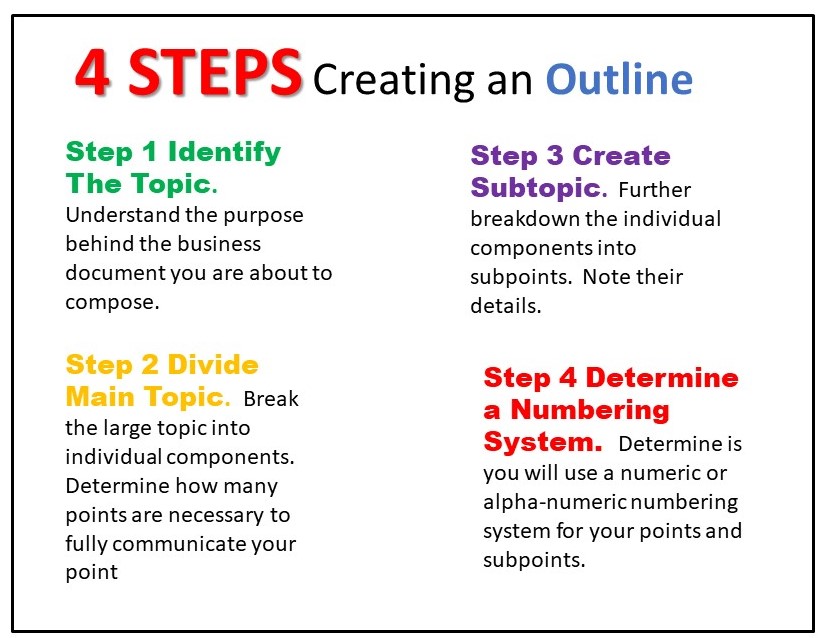Unit 12: Outlining Your Message
Learning Objectives
 After studying this unit, you will be able to
After studying this unit, you will be able to
-
-
- apply outlining techniques to drafting documents
-
Introduction
Once the organizing principle has been determined, create an outline for the message. An outline will help plot the bare-bones structure of the message so it can fleshed out into full sentences and paragraphs. Outlining helps writers get past one of the most terrifying moments in the writing process: writer’s block. Even after completing all the other steps of the writing process explored above, freezing up while staring down a blank screen is an anxiety-driven mental bottleneck that often comes from either lacking anything to say or thinking that the first draft has to be perfect. Drafting is supposed to produce a sketchy, disappointing mess only because the goal at this stage is to get ideas down fast so that you can fix them up later in the editing stage.

Outlining is a structured brainstorming activity that helps keep you on track by assigning major, overarching ideas and relatively minor, supporting points to their proper places in the framework of your chosen organizing principle. At its most basic form for a three-part message, an outline looks like the following:
You can add further points in the body and, as shown in the middle of the Figure 12.1, subdivide them even further with lowercase roman numerals, regular numbers, lowercase letters, etc. depending on the size of the document and the support needed. View the video Outlines, by UNC Writing Center for an overview of the outlining process.
Table 12.1 presents an outline of an email message for someone who wants to subscribe to a snow-removal service. The draft of the email message is also presented to demonstrate how to move from the outline to the completed product.
Table 12.1: Brief Message Outline as a Basis for an Email Draft
Message Outline
|
Email Message Draft |
|---|---|
| Greetings!I am interested in your snow-removal service this winter.
We’re at 5034 Tofino Crescent, and our driveway can fit four cars, so how much would that come to for the prepaid service? Alternatively, if we decide to do the snow removal ourselves for most of the winter but are in a jam at some point, is it possible to call you for one-time snow removal? How much would that be? Also, do you offer any discounts for first-time customers? Warm regards, Christine Cook |
Once an outline is in place, the details of each point can be fleshed out into full sentences and other conventional message components as well.
The specific architecture of the outline depends on the organizing principle chosen as appropriate to convey the writing purpose. Table 12.2 below demonstrates three principles.
Table 12.2: Outline Possibilities Based on Organizing Principles
| Organizing Principle | Outline |
| 1. Chronology & 5W+H |
|
| 2. Comparison & Contrast |
|
| 3. Pros & Cons |
|
As we shall see later in the textbook, outlining is key to organizing other projects such as presentations and reports. Outlining keeps you on track and prevents wasted efforts.

Key Takeaways
 Begin your draft by outlining the major and minor points in a framework based on the organizing principle appropriate for your purpose so that you can flesh it out into full draft sentences after.
Begin your draft by outlining the major and minor points in a framework based on the organizing principle appropriate for your purpose so that you can flesh it out into full draft sentences after.
Exercises
 1. Find a sample article or document and break it down into a hierarchically structured outline with brief points for each level of organization. Follow the numbering divisions in the outline template given at the beginning of this section. Does this help you understand the structure of the message that you otherwise didn’t consider but nonetheless relied on to understand it?
1. Find a sample article or document and break it down into a hierarchically structured outline with brief points for each level of organization. Follow the numbering divisions in the outline template given at the beginning of this section. Does this help you understand the structure of the message that you otherwise didn’t consider but nonetheless relied on to understand it?
2. Outline your next substantial email (i.e., more than a hundred words in length) using hierarchical notes following the structure given at the beginning of this section. Does doing so offer any advantages to approaching the writing process without a plan?
Creating an outline takes some upfront time and effort, but it will save considerable back-end time and effort in the composing and revising stages.

